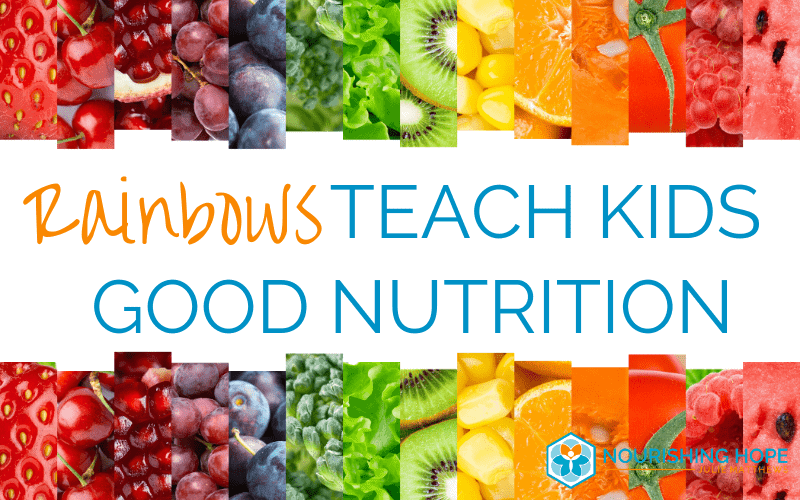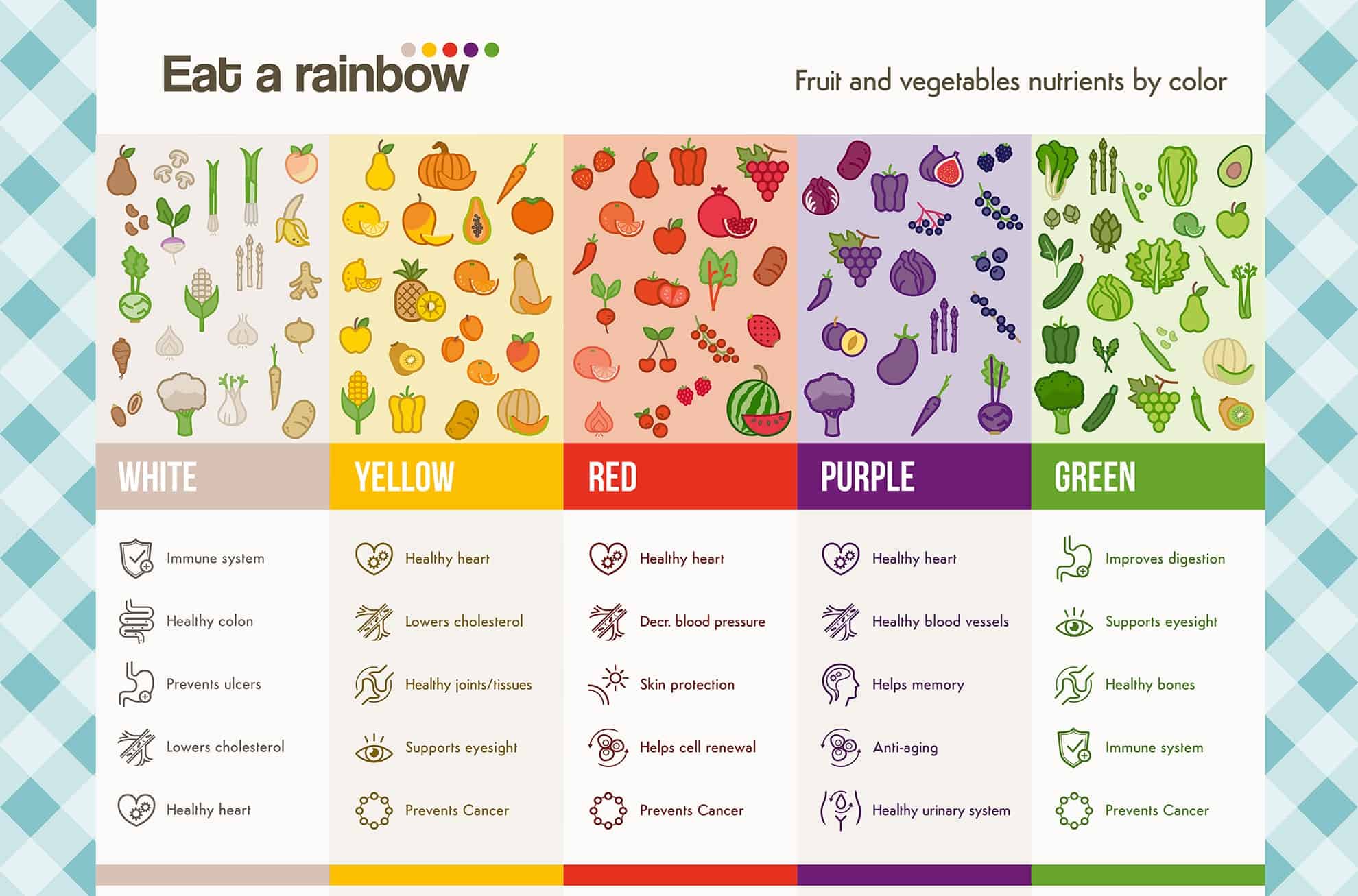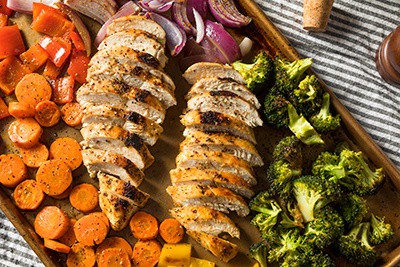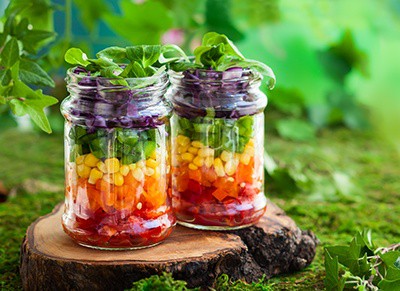
Have you been trying to get more nutrients (and vegetables) into your child?
As a nutritionist specializing in children with autism, ADHD, and related neurodevelopmental delays, I can share with you that most parents I work with are worried about their child’s nutrition.
But thankfully, with some understanding of good nutrition and a few creative ideas, they all became confident they could feed their child nutritiously, even those with picky eaters!
One great way to boost nutrients is to encourage kids to eat a rainbow of colored foods.
Firstly, kids love rainbows! And healthy veggies and fruits come in a rainbow of colors; in addition to vitamins and minerals, they contain phytonutrients derived from natural plant pigments that give them their bright colors!
So eating brightly colored plant foods, a “rainbow” of them (not artificial dyes), provides a variety of nutritious phytonutrients for good health.
Using a rainbow as your guide makes it easy for kids to understand and fun to pursue, and helps boost nutrients that parents are trying to get them.
Engaging children will improve your success. The more they are involved with their food choices, picking them out, preparing them, and maybe even growing them, the more they will enjoy and eat them. This also helps parents increase creativity with food choices. It’s easy to get stuck in a rut making the same one or two options everyday, invite fresh ideas and explore.
So a simple rule of thumb… remember to eat a rainbow of fruits and vegetables each day. And teach your kids to do the same.
Colors and their Nutrient Benefit
Here are some corresponding colors and their nutrient counterpart:

Anthocyanins: Anthocyanins produce the blue, purple, red color found in berries and grapes. Anthocyanin foods contain antioxidants that support health.
Lycopene: Lycopene is a carotenoid found in tomatoes. Studies show lycopenes have a positive effect on heart health.
Beta-carotene: The orange/yellow color in many fruits and vegetables. Humans convert beta-carotene to vitamin A. Vitamin A assists with growth and development and vision. It is also very important for a healthy immune system: specifically for regulatory T cells, which help prevent an immune response against “self” (i.e. an autoimmune response).
Lutein: Green and yellow plants produce lutein. Lutein is concentrated in the macula of the retina in the eye of humans and plays an important role in vision and eye health.
Zeaxanthin: Zeaxanthin is a compound very similar to lutein, which gives red bell peppers their orange and red color. Being the same chemical structure (with a different double bond) as lutein, it has similar benefits for the eyes.

Red:
Red pepper, Swiss chard, radish, tomato, beets, red onion, watermelon, strawberries, raspberries, cherries (pitted), cherry tomatoes, red grapes
Orange:
Butternut squash, carrot, pumpkin, sungold cherry tomatoes, sweet potato, mango, cantaloupe, apricots, peach, nectarines, papaya, orange, grapefruit
Yellow:
Yellow bell pepper, summer squash, golden beets, corn, lemon, golden raspberry, pineapple, banana, yellow tomato, pear
Green:
Artichoke, asparagus, lettuce, brussels sprouts, collard greens, kale, zucchini, green grapes, kiwi, honeydew melon
Blue:
Blueberries
Blue corn
Blue potato
Purple:
Beets, Purple kale, purple broccoli, purple brussels sprouts, purple cabbage, purple cauliflower, purple asparagus, purple carrots, blackberries, concord grapes, plums, eggplant
Fruits and vegetables also contain many other vitamins and minerals such as vitamin C, folate, potassium, magnesium, and calcium. One of the best nutrients fruits and vegetables contain is fiber. Fiber helps keep our good bacteria healthy and supports good digestion.
Children can choose their favorites
As I mentioned, when kids are engaged, they eat more healthy food.
One great way to do this is to let them choose what they want to eat or try for the first time.
You can make this a learning experience and get more nutrition into your child.
I created a handout for you that can help (download it here).

The handout includes a colorful chart for your refrigerator with a rainbow of fruits and vegetables for dozens of ideas, a 2020 Veggie Planner, and a coloring page to get your child involved in the fun!
Print out the chart and put it on your refrigerator. Show the chart to your child and discuss how different colors have different nutrients (and how cool it is!), and then let them choose which color category and/or food choices they’d like to try.
In addition to helping your child, the chart is a great tool to remind you of new vegetable and fruit options when you are shopping and cooking.
Even make it a game. Take on the challenge each week as a family of trying a new fruit or vegetable on this list. Sunday is often our day to cook something new and different together as a family. Make a side dish with a new vegetable, or even a gluten-free pie with a new fruit. If you do it week after week, you can sprinkle in some delicious desserts between your vegetable dishes to keep the game interesting and exciting.
Rainbow Meal Ideas
Here are some rainbow ideas kids love.
Fruit and Vegetable Kebabs
 Fruit kebabs are a great way to get kids to try new fruits. They are easy to eat. Pretty and festive for a party. And loaded with nutrients. Use any fruits you like: such as watermelon, mango, berry, or melon. For those on a low salicylate diet, use complaint fruit (such as: pear, mango, golden delicious apples, or whatever works for your child).
Fruit kebabs are a great way to get kids to try new fruits. They are easy to eat. Pretty and festive for a party. And loaded with nutrients. Use any fruits you like: such as watermelon, mango, berry, or melon. For those on a low salicylate diet, use complaint fruit (such as: pear, mango, golden delicious apples, or whatever works for your child).
Add Vegetables
For kids new to eating vegetables, the combination of foods they like (fruit) with unknown foods (vegetables) is a good way to encourage exploration of (and success in eating) vegetables.
Making them rainbow colored is so fun. People of all ages love them. And they are filled with nutrients.
One Sheet Pan Meal
 One sheet pan meals are very popular these days because they are so easy to make and clean up. Place your meat and vegetables (as shown here as a rainbow of colors) on one sheet pan and cook until everything is done. Serve the meal on the table straight out of the oven, for a beautiful display of colorful vegetables.
One sheet pan meals are very popular these days because they are so easy to make and clean up. Place your meat and vegetables (as shown here as a rainbow of colors) on one sheet pan and cook until everything is done. Serve the meal on the table straight out of the oven, for a beautiful display of colorful vegetables.
Rainbow Salad

Another beautiful way to get a rainbow of colors is from a rainbow salad. When I’m trying to batch prepare meals for the week, I often prepare multiple salads in mason jars, so we can grab it and go. If you add salad dressing to the bottom it doesn’t make the salad mushy. You wait until you area ready to eat it, shake it to “toss” the salad with the dressing and you’re all set.
There are many ideas and possibilities. Make a smoothie and layer it in the blender in rainbow order, then blend to see what color it is. Make art; for example, your child can make a rainbow on a plate using fruits and vegetables. Then eat it.
Share your favorite rainbow meals with us.




How long does one need to avoid phenols if seeing a reaction?
It depends on the child. It could be as little as few days for some, a bit longer for others.